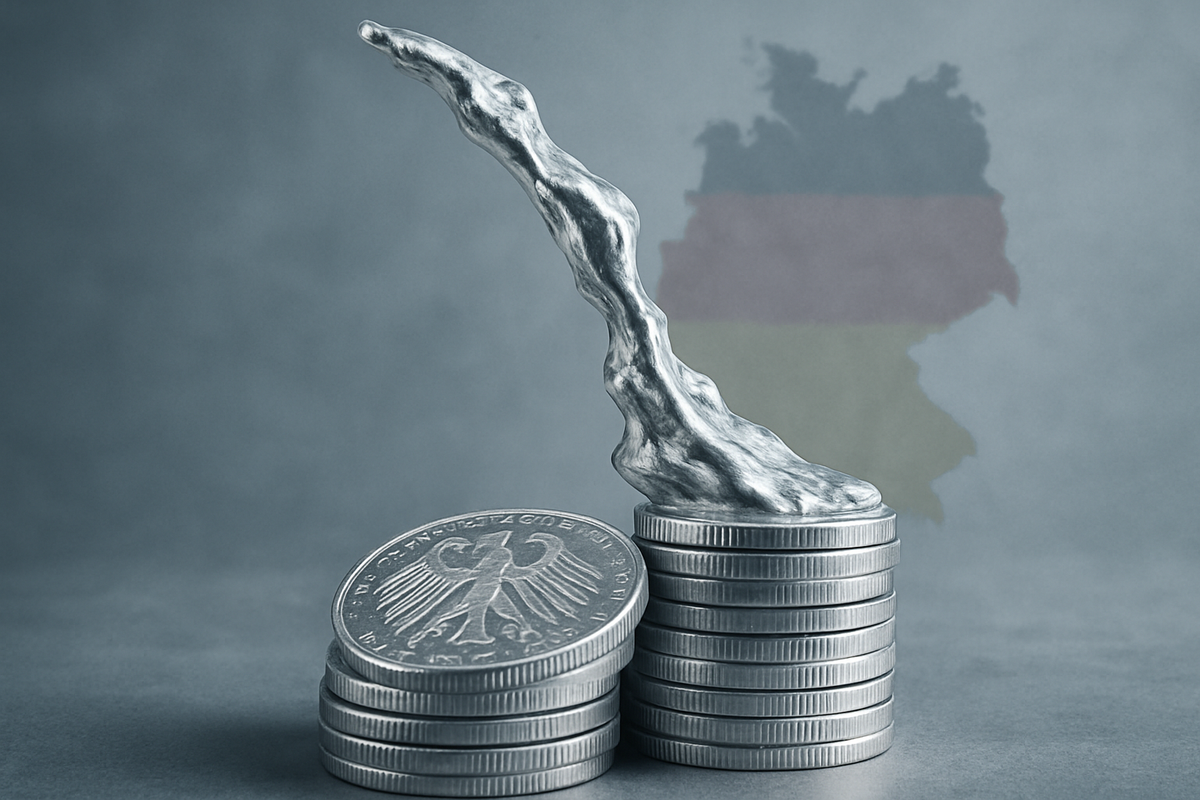
Germany, a nation known for its prudent financial management, has made a surprising and significant decision that reverberates through the numismatic and precious metals markets. On October 17, 2025, just days before this report, the Deutsche Bundesbank announced an immediate halt to the production and issuance of several upcoming commemorative silver coins. This unprecedented move, impacting collector coins such as the 25-euro "Three Kings" and the 20-euro "125 Years of the Wuppertal Suspension Railway," stems directly from the dramatic surge in global silver prices, which has pushed the intrinsic material value of these coins far beyond their stated face value.
This halt carries immediate implications. For the German mints, it means disrupted production schedules and a pressing need to re-evaluate future precious metal coin programs. The German government, through the Federal Ministry of Finance, faces the imperative of reviewing its long-standing policies on commemorative coin composition and pricing to prevent financial losses. While the global precious metals market is unlikely to be swayed by this specific demand shift, Germany's decision serves as a potent indicator of silver's escalating value, reinforcing its perception as a valuable commodity and a hedge against inflation in an uncertain economic climate.
The Silver Surge: Germany's Latest Numismatic Challenge
The recent decision by the Deutsche Bundesbank to postpone the issuance of two highly anticipated commemorative silver coins marks a critical juncture for Germany's official numismatic program. The 25-euro collector coin "Three Kings," originally scheduled for release on November 20, 2025, and the 20-euro collector coin "125 Years of the Wuppertal Suspension Railway," planned for January 22, 2026, are now indefinitely on hold. The core reason, explicitly stated by the Bundesbank, is that "the material value of the German 20-euro and 25-euro silver coins is now significantly higher than their respective face values," rendering their production and sale at the intended price economically unviable. This effectively means the cost of the silver contained within each coin would exceed its selling price, leading to direct financial losses and the risk of coins being melted down for their precious metal content.
This is not the first time Germany has grappled with the economics of precious metal coinage. A notable precedent occurred on April 13, 2011, when Germany's Federal Ministry of Finance announced a similar shift. At that time, it ceased issuing uncirculated silver €10 commemorative coins for general circulation, opting instead for copper-nickel versions. While proof silver versions continued for collectors, their minimum price was raised to €15, with provisions for further adjustments based on silver price fluctuations. This earlier move, which followed an October 2010 decision to reduce the fineness and weight of €10 silver coins, highlights a recurring challenge for governments attempting to balance tradition, collector demand, and the volatile nature of commodity markets.
Key players in this unfolding scenario include the Deutsche Bundesbank, responsible for the country's monetary policy and coin issuance, and the German Federal Ministry of Finance, which oversees the commemorative coin program and its fiscal implications. The actual production is carried out by Germany's five state mints, each identified by a unique mint mark (A, D, F, G, J). The numismatic community, including collectors and dealers, are significant stakeholders, now facing uncertainty regarding the future availability and characteristics of these highly sought-after issues. Initial reactions from the market have been largely understanding, recognizing the economic realities driving the decision, though some collectors have expressed disappointment over the delays and potential changes to the coin specifications.
The timeline leading up to this moment underscores the rapid appreciation of silver. While the specific trajectory of silver prices in the lead-up to October 2025 is complex, the Bundesbank's announcement on October 17, 2025, indicates a recent and significant spike that pushed the metal's value past a critical threshold. This swift change forced an immediate response, demonstrating the government's agility in preventing potential financial liabilities. The decision to postpone rather than cancel outright suggests a hope that future market conditions or adjusted coin parameters might allow for their eventual release, but the immediate halt signifies the severity of the current market conditions.
Companies Navigating the Silver Shift: Winners and Losers
Germany's decision, while specific to its commemorative coin program, reverberates through various segments of the financial market, creating potential winners and losers, albeit with varying degrees of impact. The most direct implications, though marginal on a global scale, are felt by companies involved in the silver supply chain and the specialized minting industry.
Silver Mining Companies: For major global silver mining companies such as Fresnillo Plc (LSE: FRES), Pan American Silver Corp. (NASDAQ: PAAS), and Wheaton Precious Metals Corp. (NYSE: WPM), the direct reduction in demand from German commemorative coins is negligible. These companies operate on a scale where overall global industrial demand (especially from green technologies like solar panels and electronics) and broad investment demand are the primary drivers of their fortunes. In fact, the underlying reason for Germany's halt – surging silver prices – is a significant boon for these miners. Higher silver prices translate directly into increased revenues, improved profit margins, and stronger cash flows, making them overall beneficiaries of the very market conditions that prompted Germany's decision. The structural supply deficit in the global silver market further underpins their strong financial position.
Precious Metals Trading Companies: Companies that trade physical silver, including those supplying blanks to mints, might experience a minor dip in specific orders from German mints for these particular coins. However, this could be largely offset by increased investment demand for silver bullion as the German government's action inadvertently underscores silver's growing intrinsic value. While specific publicly traded German precious metals dealers are not widely identified, the broader trend of rising silver prices could stimulate overall demand for physical silver products, benefiting the sector as a whole. Conversely, any trading firm holding significant inventory of silver blanks specifically for these now-postponed German coins might face short-term inventory challenges.
Minting Equipment Manufacturers: This segment presents a mixed picture. Manufacturers of traditional coin presses might see a slight reduction in orders for silver-specific machinery if Germany and other nations significantly scale back precious metal coinage. However, companies that are adaptable and forward-looking stand to gain. Schuler AG (OTC: SCHUY), a publicly traded German company and a global leader in coinage equipment, is a prime example of a potential winner. Schuler has been instrumental in developing assembly facilities for Germany's innovative polymer-ringed coins. As Germany explores "adjusted parameters" for future coins, potentially involving reduced silver content, alternative alloys, or even non-metallic materials, Schuler's expertise in diverse minting solutions positions it to capitalize on these shifts. This strategic pivot towards new materials could lead to new demand for specialized equipment, mitigating any loss from reduced silver coin production.
Alternative Materials Suppliers: The move away from high-purity silver for some coins opens doors for suppliers of alternative materials. This includes producers of copper-nickel alloys and advanced polymers. While the demand from coin minting is a tiny fraction of the overall market for these materials, major diversified mining companies like BHP Group (NYSE: BHP) and Rio Tinto Group (NYSE: RIO), which produce copper and nickel, could see a marginal, albeit indirect, benefit. For specialized polymer materials, particularly those used in Germany's advanced polymer-ringed coins, companies like BASF SE (FWB: BAS), a leading German chemical company, could potentially be suppliers. While the impact on their vast operations would be minimal, it represents a niche opportunity for innovation in coinage materials. This shift highlights a broader trend towards more cost-effective and secure coin compositions, which could benefit companies specializing in advanced material science.
Wider Significance: A Bellwether for Global Precious Metals Policy
Germany's decision to halt commemorative silver coin production due to soaring material costs is far more than a localized numismatic issue; it serves as a significant bellwether for broader industry trends in precious metals and government monetary policy worldwide. This action underscores the intensifying pressure on governments and national mints to manage the economics of coinage in an era of volatile commodity prices and persistent inflation concerns. It highlights a global challenge where the intrinsic value of a metal can quickly outstrip its face value, rendering traditional coinage unsustainable.
This event fits into broader industry trends marked by a structural supply deficit in the global silver market. Demand for silver, particularly from industrial applications like photovoltaics, electric vehicles, and 5G technology, continues to outstrip mining supply. This robust industrial appetite, combined with sustained investment demand for silver as a safe-haven asset, has created an environment of upward price pressure. Germany's halt is a direct consequence of this market dynamic, indicating that even sovereign mints are not immune to the economic realities dictated by the global silver supply-demand imbalance. It signals to other nations that similar adjustments to their precious metal coinage programs might become necessary if current price trends persist.
The ripple effects could extend to other national mints and their partners. Countries that issue high-purity silver commemorative or bullion coins might re-evaluate their production schedules, silver content, or pricing strategies. This could lead to a global trend of either increasing the nominal value of precious metal coins, reducing their fineness, or shifting towards alternative materials, as Germany itself has done in the past with copper-nickel. Such a shift could impact global demand for silver from the minting sector, potentially reallocating that demand to industrial uses or investment products. Furthermore, it could spur innovation in anti-counterfeiting measures for coins made with less precious metals, as their value would be tied more to their collectibility and security features than their intrinsic material.
From a regulatory and policy perspective, Germany's move could prompt a re-examination of budgetary laws and minting regulations in other countries. The German government's inability to issue coins where material value exceeds face value due to budgetary law highlights a potential legislative constraint. Other nations might consider flexible pricing models for collector coins that automatically adjust with market prices, or more direct subsidies for their mints to absorb commodity price volatility. Historically, such adjustments are not unprecedented. During periods of high inflation or commodity spikes, many countries have debased their coinage, reducing precious metal content or switching to base metals. The United States, for instance, removed silver from its circulating dimes and quarters in 1965 due to rising silver prices, a move that parallels Germany's current challenge, albeit on a different scale and for different types of coins. This historical precedent suggests that Germany's current adaptation is a pragmatic response to economic pressures rather than an isolated incident.
What Comes Next: Navigating the Future of Numismatics
Germany's decisive action heralds a period of necessary adaptation and strategic re-evaluation within its numismatic program, with potential ramifications for the global coin market. In the short term, the immediate focus will be on the "adjusted parameters" that the Deutsche Bundesbank mentioned. This could involve several scenarios: the postponed 20-euro and 25-euro coins might be reissued with a higher face value (as Germany plans to do with other silver coins in March 2026, raising 20€ coins to 25€ and 25€ fine silver coins to 35€), a reduced silver fineness, or even a smaller physical size. The mints will need to recalibrate production, and the official sales agency, Münze Deutschland, will have to manage collector expectations and communicate these changes effectively. There's also a possibility that some designs might be entirely re-envisioned for alternative, less precious materials, such as the polymer technology Germany has already pioneered.
Looking further ahead, the long-term possibilities point towards a more diversified and strategically managed commemorative coin portfolio. Germany may increasingly lean on its innovative polymer-ringed coin technology for future issues, especially for denominations where the intrinsic value of traditional precious metals becomes prohibitively expensive. This could position Germany as a leader in advanced coin manufacturing, encouraging other nations to explore similar secure and cost-effective alternatives. Furthermore, a greater emphasis might be placed on the artistic and historical significance of commemorative coins, rather than solely their precious metal content, fostering a different kind of collector appeal.
Market opportunities and challenges will undoubtedly emerge from this shift. For the silver market, while the direct impact on global demand from coin production is small, Germany's move reinforces the narrative of tight supply and strong underlying demand, potentially sustaining higher silver prices. This creates opportunities for silver investors and miners, but a challenge for industries that rely on stable, lower silver prices. For minting equipment manufacturers like Schuler AG (OTC: SCHUY), the challenge of adapting to new materials presents an opportunity to develop and supply cutting-edge machinery for alternative coin compositions. For collectors, the challenge lies in adapting to potentially higher prices or different material compositions, while the opportunity might be in the increased rarity of existing high-purity silver issues.
Potential scenarios and outcomes include a permanent shift in Germany's commemorative coin policy towards higher face values or alternative materials, setting a precedent for other European nations. Another scenario could see a temporary halt, with production resuming if silver prices retreat significantly, though the underlying structural demand suggests this might be a less likely long-term outcome. The most probable path involves a pragmatic blend of adjustments, where certain high-value collector coins retain precious metal content at higher nominal prices, while broader commemorative programs explore innovative, cost-effective materials. This strategic pivot will be crucial for maintaining the viability and appeal of Germany's numismatic offerings in a dynamic global market.
Wrap-Up: A New Era for Precious Metal Coinage
Germany's recent decision to halt the production of specific commemorative silver coins due to surging material costs marks a pivotal moment for its numismatic program and offers a stark illustration of the economic pressures facing governments in a volatile commodity market. The key takeaway is clear: the intrinsic value of silver has reached a point where traditional coinage at fixed face values is no longer sustainable without incurring direct financial losses. This pragmatic response from the Deutsche Bundesbank, announced on October 17, 2025, reflects a necessary adaptation to global economic realities, particularly the persistent structural supply deficit and robust demand driving silver prices upwards.
Moving forward, the market will likely see continued innovation in coin manufacturing. Germany's willingness to explore "adjusted parameters" for future issues, including higher nominal values for existing silver coins and a potential pivot towards advanced materials like polymers, signals a new era for precious metal coinage. This shift is not merely about cost-cutting; it's about preserving the integrity and financial viability of national coin programs while adapting to changing market dynamics. The event underscores silver's role as a valuable investment commodity, reinforcing its appeal to investors seeking a hedge against inflation and economic uncertainty.
For investors, the German halt serves as a powerful indicator of underlying strength in the silver market. While the direct demand impact from commemorative coins is small, the government's acknowledgment of silver's escalating value is a significant psychological boost. Investors should watch for further announcements from the Deutsche Bundesbank regarding the revised parameters for future coin issues, as these will provide insights into Germany's long-term strategy for precious metals in its coinage. Additionally, monitoring global silver supply-demand dynamics, particularly industrial demand trends and investment flows, will be crucial. The actions of other national mints in response to similar pressures could also signal broader shifts in the global numismatic and precious metals landscape in the coming months. This event is a reminder that even in the seemingly stable world of government-issued currency, market forces can necessitate profound and surprising changes.
This content is intended for informational purposes only and is not financial advice






